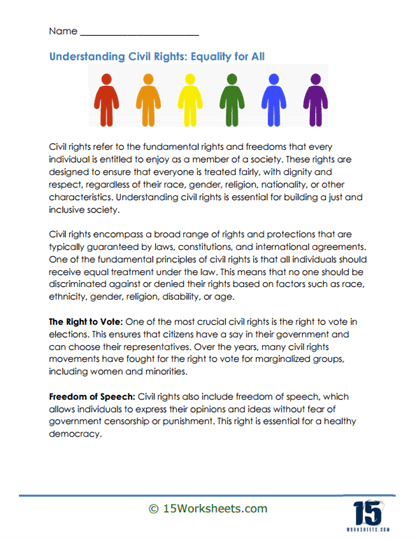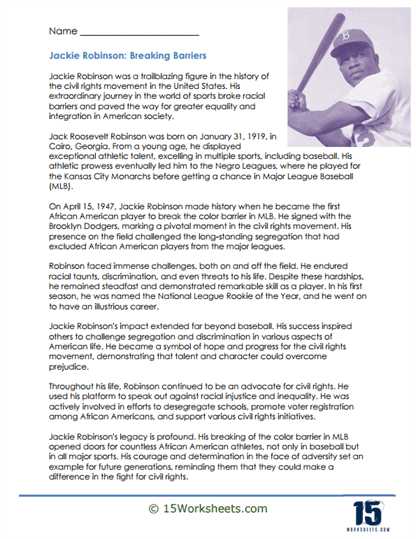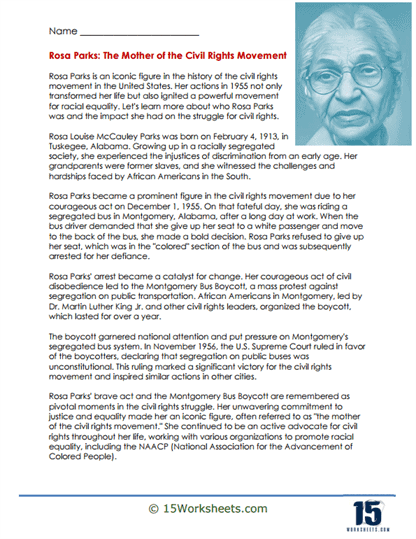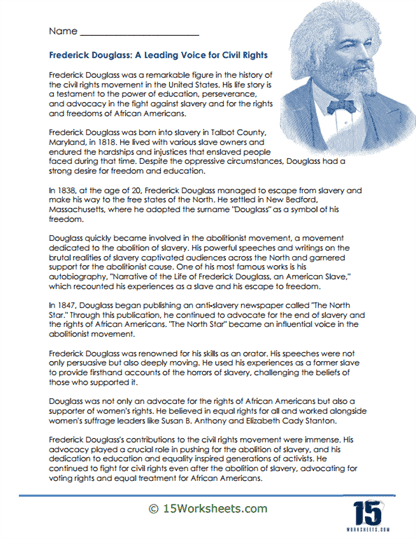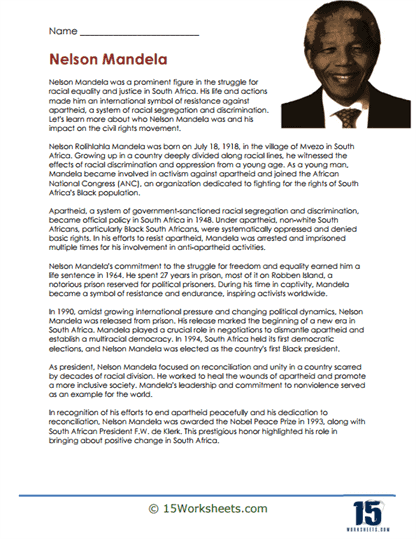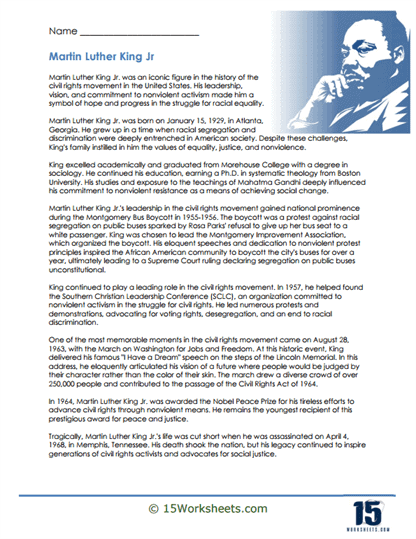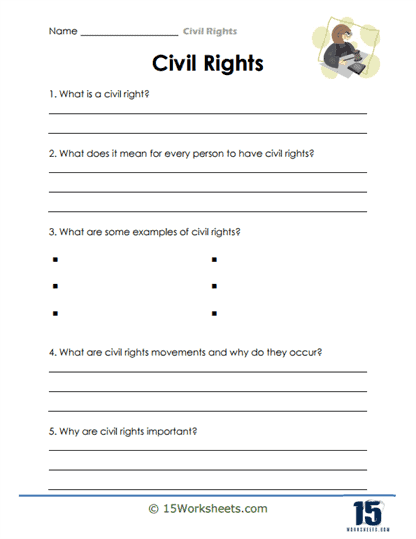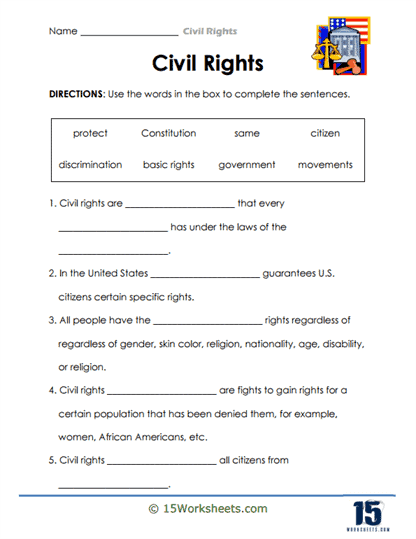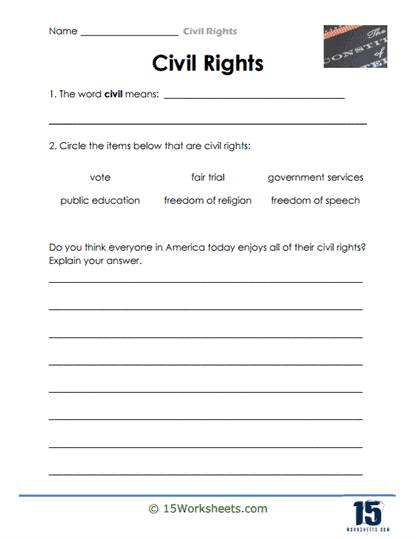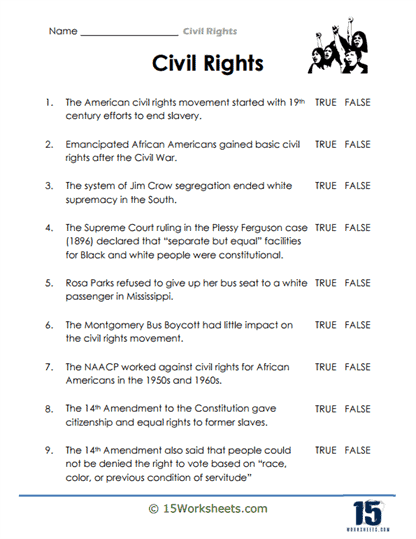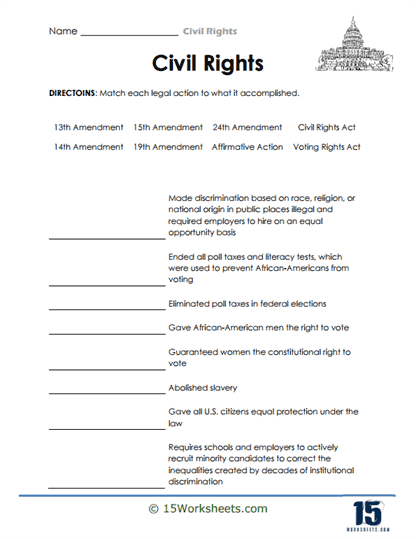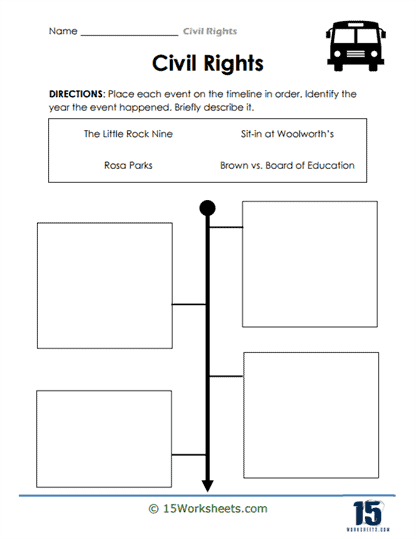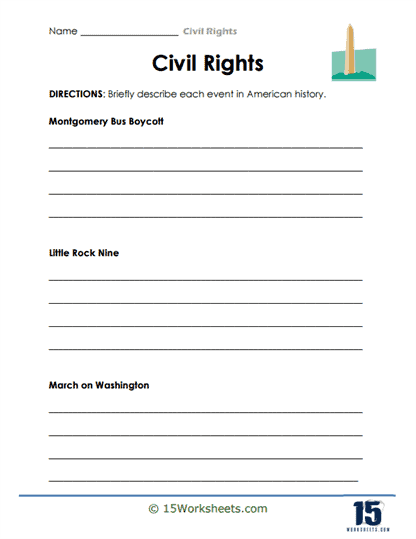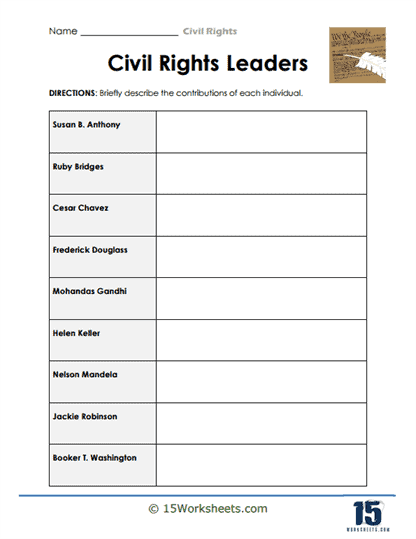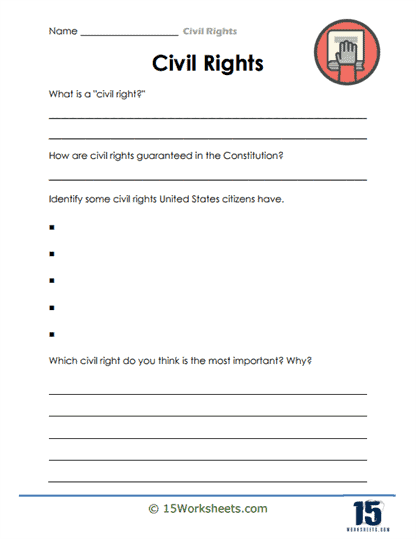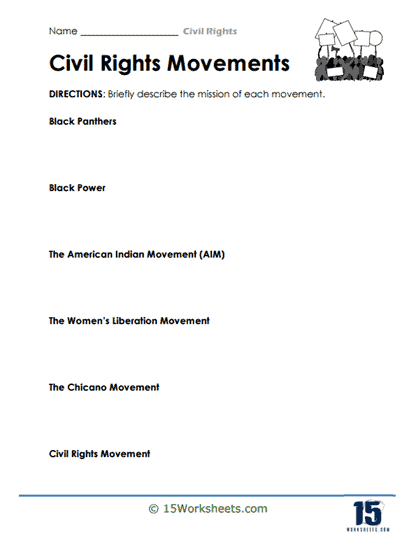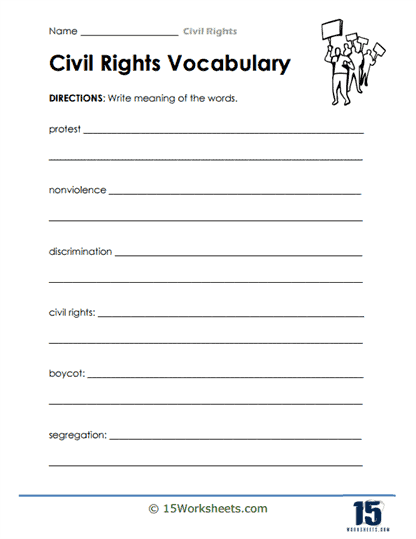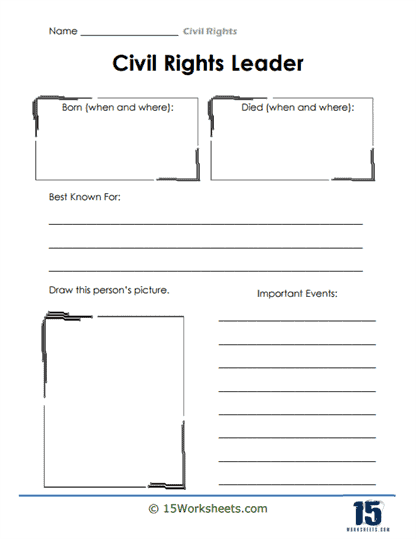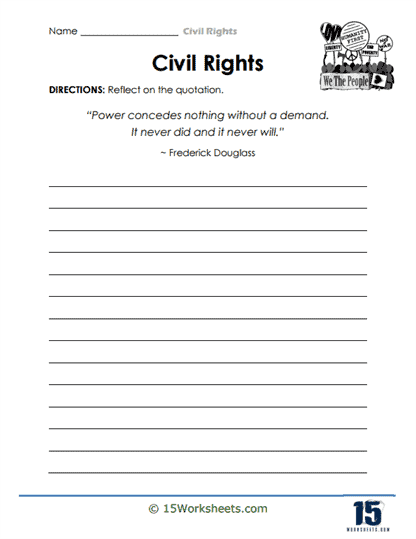Civil Rights Worksheets
About These 15 Worksheets
The Civil Rights Movement stands as one of the most transformative and defining eras in American history. The worksheets created to teach students about this pivotal period in the 1950s and 1960s go beyond mere facts and dates-they serve as a gateway into a deeper exploration of the fight for justice and equality. During these turbulent decades, African American leaders, activists, and ordinary citizens rallied against the oppressive forces of racial segregation and discrimination, seeking not only to dismantle unjust laws but to reshape the very fabric of American society. These resources are designed to help students connect with the legacy of these struggles in meaningful and enduring ways.
Each worksheet included in this collection is crafted with the goal of making history come alive. Rather than simply presenting students with a passive recounting of events, these exercises invite them to engage actively with the material. By studying the marches, boycotts, sit-ins, court battles, and legislative victories that marked the Civil Rights Movement, students are encouraged to analyze the motivations, strategies, and resilience of those who fought for change. They learn about iconic figures like Dr. Martin Luther King Jr., Rosa Parks, Malcolm X, and lesser-known but equally important activists who worked tirelessly, often at great personal risk, to push America closer to its professed ideals of freedom and equality for all.
But the importance of these worksheets extends far beyond imparting historical knowledge. Understanding the Civil Rights Movement is crucial not just for grasping the past but for making sense of the ongoing struggles for racial equality and justice that persist today. These lessons encourage students to look at history as something alive-something that continues to evolve and impact the present. By critically analyzing the struggles of the 1950s and 1960s, students gain insight into contemporary movements, helping them to recognize the parallels between past and present. The fight for racial justice is not something consigned to history books; it is a continuing effort that each new generation must confront in its own way.
In a broader sense, the Civil Rights Movement serves as a profound reminder that the rights and freedoms we often take for granted were hard-won. By studying this period, students come to realize that democracy is not a static system but one that requires constant vigilance and participation. This is perhaps one of the most critical lessons these worksheets aim to impart: the importance of civic engagement. Whether through voting, activism, or simply standing up against injustice in everyday life, students are encouraged to see themselves as active participants in the ongoing story of democracy. They learn that they, too, have a role to play in the preservation and expansion of civil rights, not just for themselves but for their communities and future generations.
These lessons offer a window into the broader significance of diversity and inclusion in a democratic society. The Civil Rights Movement wasn’t just about laws-it was about challenging the very notion of who gets to be fully included in the American dream. By examining this history, students are better equipped to understand the complexities of living in a diverse nation, where different experiences, identities, and perspectives must be recognized and respected. The worksheets help to cultivate a more nuanced understanding of the importance of inclusivity, teaching students that diversity is not merely something to be tolerated but something to be celebrated and protected.
Types of Exercises
First up, the “Equality for All” worksheet challenges students to imagine a world where everyone gets equal slices of pizza-because nothing says justice like pepperoni parity. Then there’s “Jackie Robinson,” where learners step into the cleats of the baseball legend, dodging fastballs and fast-talking bigots alike. “Rosa Parks” invites students to take a stand by sitting down, proving that sometimes the most powerful protests happen on public transportation. Meanwhile, “Frederick Douglass” has students practicing their oratory skills, channeling their inner abolitionist with speeches that could make even the stiffest history teacher shed a tear.
But wait, there’s more! “Nelson Mandela” takes students on a journey from prison cell to presidential palace, all while maintaining a wardrobe of impeccable suits. “Martin Luther King Junior” encourages dream interpretation-turns out, his dream wasn’t about flying or showing up to school naked. “Meaning and Examples” helps students decode the cryptic language of civil rights, while “Sentence Fillers” lets them play Mad Libs with history. “What is Civil?” poses the age-old question: Is it possible to argue politely? “True or False” keeps them on their toes, especially when the answer is “It’s complicated.” “Legal Actions” has students donning imaginary wigs and gavels, “Placing Events” turns them into chronological detectives, and “Big Events” ensures they never confuse the March on Washington with a parade. “The Leaders” introduces the who’s who of civil rights, while “Are They Guaranteed?” explores the fine print of freedom. “Civil Rights Movements” offers a crash course in activism, “Civil Rights Vocabulary” expands their lexicon beyond “equality,” and “Civil Rights Leaders” ensures they can distinguish their Malcolms from their Martins. Finally, “Frederick Douglass Quote” challenges students to decipher 19th-century wisdom, proving that some truths are indeed self-evident-and eloquently phrased.
Here is a look at the format of the various worksheets (above):
Reading Comprehension Passages – These passages often include excerpts from speeches, biographies of civil rights leaders, or descriptions of key events. Students read these passages and answer questions to test their comprehension.
Multiple-Choice Questions – These questions typically cover key facts, dates, figures, and events of the Civil Rights Movement. They help assess students’ retention of factual information.
Writing Prompts – Essays allow students to delve deeper into topics such as the significance of landmark events like the Montgomery Bus Boycott, the March on Washington, or the passage of the Civil Rights Act of 1964. They encourage critical thinking and personal reflection on the movement’s impact.
Fill-in-the-Blanks – These exercises help reinforce key vocabulary and concepts related to the Civil Rights Movement.
Timeline Activities – Students might be asked to create timelines of major events during the Civil Rights era, helping them understand the chronological progression and the cause-and-effect relationships between events.
Primary Source Analysis – This involves the study of historical documents, speeches, photographs, and other materials from the era, allowing students to engage directly with the sources that shape our understanding of history.
Role-Playing and Simulations – These activities might involve students taking on the roles of various figures from the Civil Rights Movement, helping them to empathize with and understand different perspectives.
Discussion and Debate – Facilitated discussions or debates on key issues or controversial topics of the time, such as nonviolent resistance versus armed self-defense, help develop critical thinking and public speaking skills.
Importance of Studying Civil Rights for Students
The study of civil rights is not just an exploration of the past; it is a profound opportunity for students to understand the very fabric of American society, the ongoing pursuit of justice, and their own roles as future changemakers. By delving into the Civil Rights Movement, students gain invaluable insights into historical contexts that have shaped the present and will continue to influence the future. Civil rights education goes beyond textbook knowledge, offering lessons in empathy, critical thinking, and social responsibility that resonate deeply in our diverse and evolving world.
Understanding Historical Context
Learning about the Civil Rights Movement is like opening a window to one of the most transformative periods in American history. It allows students to explore the social, political, and cultural forces that influenced the United States in the 1950s and 1960s, a time when the nation was grappling with deep racial divides and systemic discrimination. Understanding this period is essential because it helps students see how the actions of ordinary citizens, through collective courage and perseverance, led to significant legal and social reforms that redefined the country. Without this historical context, it is difficult to fully grasp how the principles of democracy and equality have been tested and reshaped over time.
Studying civil rights history enables students to connect past struggles with current social issues. It brings history alive by showing that the fight for justice is not an abstract concept confined to a distant era; it is a living, breathing process that continues to shape our society today. By examining the historical context of civil rights, students learn how the past informs the present and how they, as individuals, can contribute to a better future.
Recognizing the Struggle for Equality
The struggle for equality is a central theme in civil rights education, and it is a struggle marked by profound hardships, sacrifices, and resilience. Students who study the Civil Rights Movement come to understand the enormity of the fight for racial justice-an often painful and difficult battle that required immense bravery from those who faced violence, intimidation, and systemic oppression. Figures such as Martin Luther King Jr., Rosa Parks, and John Lewis are often celebrated for their contributions, but the movement was fueled by countless unsung heroes, many of whom risked their lives for the cause.
By recognizing this long and arduous struggle, students develop an appreciation for the sacrifices made by civil rights activists. They come to see that the progress achieved was neither swift nor easy, and they gain a deeper respect for the principles of equality and justice that are often taken for granted today. This awareness fosters a sense of responsibility to continue the work begun by those who came before, ensuring that the legacy of the Civil Rights Movement is not forgotten or undermined.
Developing Civic Awareness and Empathy
One of the most powerful outcomes of studying civil rights is the development of civic awareness. Students are not only learning about history-they are learning about their role within a democratic society. The Civil Rights Movement provides a blueprint for how individuals, regardless of their background, can engage in civic action to advocate for change. It demonstrates that democracy thrives when citizens are informed, active, and committed to the principles of justice and equality.
Civic awareness also brings with it a deep sense of empathy. When students study the challenges faced by marginalized groups-whether during the Civil Rights era or in contemporary society-they begin to see the world through the eyes of those who have been oppressed. This empathy is crucial in building a more inclusive society, as it encourages students to embrace diversity and advocate for the rights of others. In a world where division and polarization often dominate, the ability to empathize with others is a powerful tool for promoting understanding and unity.
Appreciating Rights and Freedoms
It is easy to take for granted the rights and freedoms we enjoy today, but studying civil rights helps students understand that these freedoms were hard-won through years of struggle and perseverance. The freedoms to vote, to attend integrated schools, and to live without fear of discrimination were not always guaranteed, and many people paid a high price to secure these rights. By learning about the history of civil rights, students gain a renewed appreciation for the protections they have under the law and the importance of safeguarding these rights for future generations.
This appreciation is not merely academic-it has real-world implications. When students understand the fragility of rights and freedoms, they are more likely to be vigilant in protecting them. They realize that civil liberties, once gained, can be eroded if citizens are not vigilant. This knowledge empowers students to be active participants in their democracy, ensuring that the rights and freedoms of all people are preserved and expanded.
Learning the Power of Nonviolent Resistance
One of the most enduring lessons of the Civil Rights Movement is the power of nonviolent resistance. The movement’s leaders, inspired by figures like Mahatma Gandhi, used nonviolence as a tool to confront injustice and demand change. This strategy was not only effective in advancing civil rights, but it also left a lasting legacy that continues to influence social movements around the world.
For students, studying nonviolent resistance offers valuable insights into how social change can be achieved without resorting to violence. In a world where conflict often escalates into violence, the Civil Rights Movement provides a counter-narrative-one in which moral authority and peaceful protest triumph over oppression. This lesson is particularly relevant today, as students are increasingly confronted with issues of social justice and inequality. By learning about the power of nonviolent resistance, they are equipped with the tools to advocate for change in a way that upholds the principles of justice and humanity.
What Was the Civil Rights Movement?
Civil Rights Movement was a pivotal moment in American history that brought about significant legal and social changes, helping to move the nation closer to its ideals of equality and justice for all. The Civil Rights Movement was a social and political movement in the United States that aimed to end racial segregation and discrimination against African Americans and other minority groups, particularly in the Southern states, during the mid-20th century. It was a pivotal moment in American history that sought to secure equal rights and opportunities for all citizens, regardless of their race or ethnicity.
Participants
The movement involved a diverse group of individuals and organizations, including African Americans, white activists, religious leaders, labor unions, and civil rights organizations. Prominent figures in the movement included Martin Luther King Jr., Rosa Parks, Malcolm X, John Lewis, and many others.
Methods Used
Participants in the Civil Rights Movement used various nonviolent tactics and strategies to bring about change. These included civil disobedience, sit-ins, boycotts, voter registration drives, peaceful protests, and legal challenges to segregation and discriminatory laws.
The Civil Rights Act
The Civil Rights Act of 1964 was a landmark piece of legislation that played a crucial role in the movement’s success. It outlawed discrimination based on race, color, religion, sex, or national origin in public places, employment, and federally funded programs. It also ended racial segregation in public schools and authorized the federal government to enforce desegregation.
Voting Rights Act
Another significant piece of legislation, the Voting Rights Act of 1965, aimed to eliminate barriers that prevented African Americans from exercising their right to vote. It banned literacy tests, poll taxes, and other discriminatory practices that had been used to disenfranchise black voters.
Impact on the United States
The Civil Rights Movement had a profound and lasting impact on the United States. It not only led to legal changes but also changed the social and cultural landscape of the country. Some of its key effects include:
The end of legal segregation – The movement led to the dismantling of Jim Crow laws and the segregation of public facilities, schools, and transportation.
Expansion of civil rights – It paved the way for the expansion of civil rights for other marginalized groups, including women, LGBTQ+ individuals, and people with disabilities.
Increased political participation – The movement inspired many African Americans to become politically active and engage in the democratic process, leading to greater representation in government at various levels.
Racial consciousness and activism – The Civil Rights Movement also contributed to a heightened awareness of racial issues and spurred ongoing activism against racism and discrimination in the United States.

